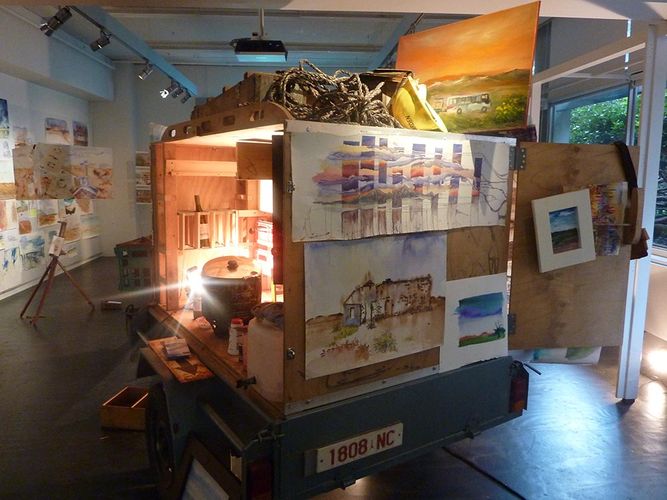Studying in the outback with Terra Oddities
Associate Professor in Landscape Architecture, Andrew Saniga, talks about his outback studio Terra Oddities and watercolour stunts at dawn.
Creativity can be stimulated in many different ways. Immersing students in challenging fieldwork engenders self-belief and confidence in one’s creative potential.
Fieldwork should embrace improvisation. Making things up as one goes along develops competence and resilience which are essential for survival, in all walks of life.
My studios have focused on remote and marginal landscapes, their histories, and an array of artistic genre that such landscape have generated.

The Terra Oddities studio subject for the Master of Landscape Architecture gave students the opportunity to test relationships between the past, present and future in the creation of architecture and landscape.
The studio is set for a revival in the 2018 Masters program, having run in 2002, 2005, 2008 and 2010.
In its 2010 incarnation, fifteen staff and students went on a two-week painting trip into the South Australian Desert. Unlike most travelling studios, that head offshore, ours was firmly planted in Australia, and a remote part of it at that. Our studio took the notion of a travelling studio literally – we physically built a ‘mobile studio’, a ‘classroom that travelled’.
![[Back row, left to right] Linas Vaiciulevicius, Alex Mendelssohn, Danius Kesminas, Brent Greene, Caitlin Brosnan, Emerald Wise, Kate Fitzgerald, Stephan Moravski, Justin Bolton, Tian You, Joanne Nataprawira. [Front row, left to right] Ruth Redden, Nayan Puri, Dee-Ann Simmons, Stephanie Kaul, Andrew](https://msd.unimelb.edu.au/__data/assets/image/0011/2694395/6a49b5c0879211e79df703bca6b12b5b_content_image.jpg)
Our study site was Woomera, a village set deep in the South Australian desert. A product of Australia’s role in the Cold War, by the 1960s and 70s Woomera’s population levels reached around 6000 people. Rocket testing and related military activities were gradually scaled down through the 1990s. With drastically depleted populace and three and half pubs, its ruinous landscape still carries traces of history, running deep seams through the region.
Our early trips to Woomera featured watercolour classes at dawn. Stories of these painting stunts became somewhat legendary around the Faculty and on the 2010 trip painting ruinous desert landscapes became our chief activity.
We researched international art movements that resonated with our aims, such as earthworks artists Robert Smithson and Nancy Holt; and the Survival Research Laboratory, a US-based art outfit that invents and tests machines. The advice of various landscape artists was sought: Jack Absalom, Alex Mendelssohn, Nick and Heather Safstrom and Melbourne-based artist John Wolseley, who opened the Terra Oddities exhibition and featured in one of the student projects.

The history of Australian overland travel informed the studio, looking at itinerant figures such as Reg Sprigg (geologist), The Leyland Brothers (explorer filmmakers), Australia’s Muslim cameleers (transport) and Len Beadell (post WWII surveyor and road builder).
Perhaps the most significant inspiration was Tom Kruse, the outback mailman who repeatedly made the epic mail run between Marree and Birdsville in a 1936 Leyland Badger. John Heyer’s 1954 docudrama The Back Of Beyond was based on Kruse’s journeys.
The quality of Heyer’s award-winning cinematography became our guiding star. We ordered the film from the National Film and Sound Archive in Canberra and staged a free screening at the Woomera Theatre.

Building our mobile studio began with the purchase of a second-hand steel 6x4 trailer late one night from a bloke in Frankston. The 2010 class then spent six weeks designing and constructing a plywood box to sit atop: a unit that could store our easels, paints, paper and other useful travel gear. The trailer started conversations with local people virtually everywhere we went. In teaching via an epic (educational) road trip we learned the importance not only of ‘immersion’ but also the need to ‘expunge’ – our preconceived ideas, our expectations; our everyday normal city existences.
Article by Andrew Saniga.
Study with us
Our Bachelor of Design + Master of Landscape Architecture course combination is accredited by the Australian Institute of Landscape Architects and is recognised by the International Federation of Landscape Architects.
Apply for the Bachelor of Design
Apply for the Master of Landscape Architecture